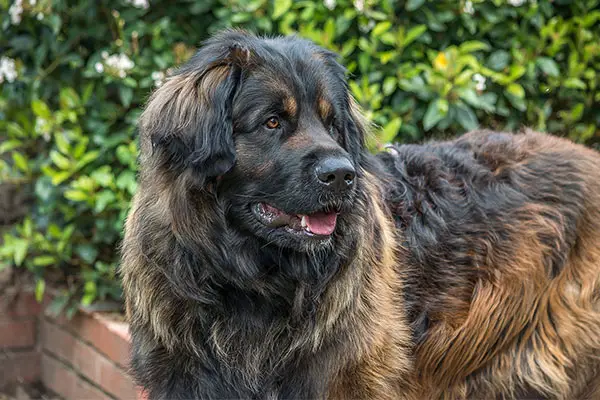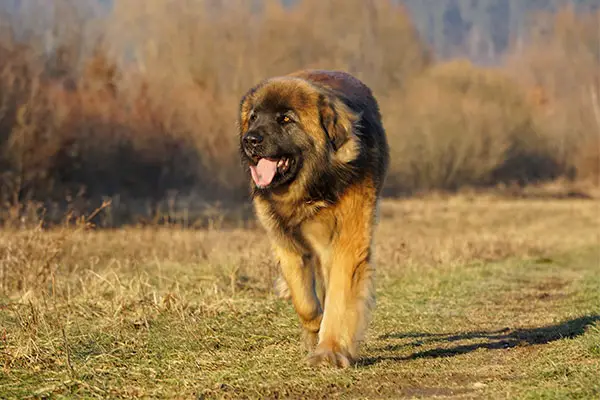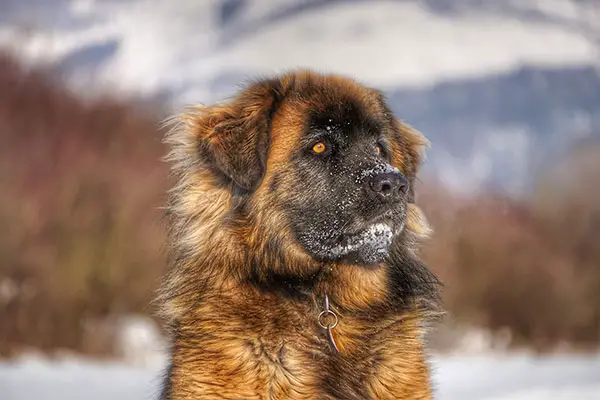Leonbergers are giant-sized dogs standing at the height of 31 inches. These dogs are known for their royal-like grace and elegance. The Leonberger features a medium-length coat, a bushy tail, and a lion-like mane around the neck and chest.
Leonbergers need early socialization and training to make them into a great family friend. Without it, their attitude will become quite a challenge. They love being with people and must not spend long periods alone. They also need a lot of space to run around, so an apartment living condition might not be the best for them.

Leonberger Breed Statistics
| Dog Breed Group | Working |
| Breed Size | Giant |
| Height | 28-31.5 inches (male); 25.5-29.5 inches (female) |
| Weight | 110-170 pounds (male); 90-140 pounds (female) |
| Lifespan | 9 years |
Leonberger Breed Ratings
| Energy level | |
| Exercise needs | |
| Requires attention | |
| Playfulness | |
| Trainability | |
| Shedding | |
| Grooming | |
| Friendly with family | |
| Friendly with kids | |
| Friendly with strangers | |
| Friendly with other dogs | |
| Prey Drive |
Leonberger History
Leonbergers originated in Germany from a place called Leonberg, hence its name. This was around 1846. According to a story, a breeder named Heinrich Essig developed the dogs to create a lion-like dog, which is a part of Leonberg’s crest.
It is said that Essig crossed a Landseer Newfoundland and a St. Bernard a couple of times. The litter of the two breeds was then crossed with a Pyrenean Mountain Dog. There was still a lot of crossing that happened before the Leonberger was developed, but sadly, there were no records.
The only thing that matters, Essig succeeded in creating a dog fit for royalty. When Leonbergers first appeared, the dogs immediately became popular in the royal and imperial households of France, Austria-Hungary, Germany, and Italy.
Among the many royals who owned the breed are Napoleon II, Prince of Wales, and Emperor Napoleon III.
By 1891, the first Leonberger clubs were established. Besides being excellent companion dogs to royalties, Leonbergers were also popular farm dogs used to pull carts. They also assisted in two World Wars, which almost caused the breed’s extinction.
Fortunately, the breed was saved by two Leonberger devotees, Stadelmann and Josenhans. A breeding program started, but this was soon taken over by the German government.
By the early 1900s, the first Leonbergers appeared in Canada and the US. Soon after that, a club was formed in 1987. However, it took a few years later, before the American Kennel Club officially recognized the breed in 2009. Now, the dogs rank 93rd as the most popular dog breed in the US.

Leonberger Temperament
The American Kennel Club describes Leonbergers as friendly, gentle, and playful. Known to be of royalty, these dogs are noble and powerful. They are usually calm and steady indoors but are athletic when outdoors.
These dogs enjoy a lot of outdoor activities, and you can also depend on them as working dogs. Anything that makes them productive is enjoyable for them – regular play sessions, not so much.
Leonbergers are loving dogs who love being part of the family. You shouldn’t cage them in or leave them alone in your backyard. Make them feel welcome and special.
Though protective instincts kick in as they mature, these dogs are not aggressive. They can be discriminating towards strangers and will bark when someone suspicious comes. When things get worse, expect that they will jump in.
Toddlers should be supervised when around these dogs. Leonberger’s size may cause them to get hurt accidentally. Dog aggression can be one of your problems, too, especially if it’s a fellow Leonberger of the same sex.
Any aggression can be taken care of with early socialization. Get them accustomed to new people, animals, sights, or sounds. Obedience training should also start at an early age. They can be dominant dogs, so make sure to instill a firm and consistent leadership.
Leonberger Care Requirements
- Nutrition: Leonbergers don’t have special dietary requirements. As long as you provide them high-quality and well-balanced meals, these dogs will be happy and healthy. Protein is an integral part of their diet, as this supports muscle growth. Fats and carbohydrates are next, which are essential in providing them their energy needs. Find great food sources where you can get these nutrients and make sure to buy only the high-quality ones. Add fruits and vegetables to your dog’s diet to aid with digestion. If you want to feed them dog food, make sure that you only choose the premium ones. These mustn’t contain fillers, additives, and other harmful preservatives that can make your dogs sick.
- Grooming: Leonbergers have medium-length coats that shed regularly. This requires daily brushing to prevent mats and tangles from forming. At the same time, this will control the amount of loose hair scattered around your home. Other than that, you should give him thorough grooming at least once a week to keep him looking his best. Take care of his undercoat and brush it all neatly. Baths can be given occasionally or as needed. Make sure to check and trim the nails regularly. Long nails can be painful and may cause discomfort to an active dog like the Leonbergers.
- Exercise: Leonbergers are active dog breeds that need a lot of space to run around. Apartment buildings may not offer the best living conditions for these dogs. Though these are generally calm dogs indoors, they require some physical activities to keep them healthy, happy and behaved. This can be in the form of daily walks or run. You can let him accompany you in biking, jogging, swimming, or hiking. Pulling a cart will also make an excellent exercise for a Leonberger dog. Another nice training you can give is agility training.
- Health: Leonbergers have a rather short lifespan, but you can probably extend this if you are aware of diseases that affect this dog breed the most. Like any other large dog breeds, Leonbergers are prone to hip dysplasia, a health condition that affects their hip joint. Leonberger Polyneuropathy is another disease that affects the bones, and this is unique to the breed. Other than bone diseases, eye diseases such as entropion and ectropion are found to be common. Feeding the right amount of nutrients is essential to prevent bloating, which is also dangerous and can be life-threatening. You can have your dog take some screening tests to detect diseases at an early stage. Observe any behavioral changes too, and if there is, take them to the vet.
- Lifespan: The life expectancy of the Leonbergers is nine years.
Famous Leonbergers
- Ariel: A Leonberger known to have delivered 18 puppies in 2009.
Fun Facts About Leonbergers
- Leonbergers originated from Germany, in a place called Leonberg.
- They were developed by a man named Heinrich Essig.
- They were beloved dogs of royalties.
- They almost went into extinction after World War I.
- They are used in search and rescue missions in Canada, Germany, and other parts of Europe.
- They were officially recognized by the American Kennel Club in 2009.

